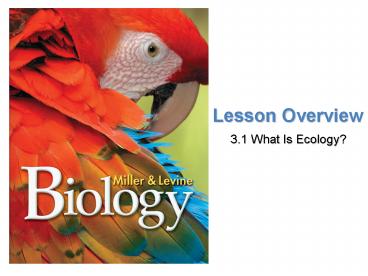Lesson Overview - PowerPoint PPT Presentation
Title:
Lesson Overview
Description:
... precipitation, humidity, wind or water currents, soil type, etc. Example, a bullfrog could be affected by abiotic factors such as water availability ... – PowerPoint PPT presentation
Number of Views:54
Avg rating:3.0/5.0
Title: Lesson Overview
1
Lesson Overview
- 3.1 What Is Ecology?
2
Studying Our Living Planet
- What is ecology?
- Ecology is the scientific study of interactions
among organisms and between organisms and their
physical environment.
3
Studying Our Living Planet
- Biosphere-
- All life on Earth and all parts of the Earth in
which life exists - Land, water, and atmosphere
- Extends from 8km above the surface to 11km below
the ocean
4
The Science of Ecology
- Ecology
- scientific study of interactions among and
between organisms and their physical environment. - Interactions within the biosphere produce a web
of interdependence between organisms and the
environments in which they live.
5
Levels of Organization
- Individual organism
- Populationa group of individuals that belong to
the same species and live in the same area - Communityan assemblage of different populations
that live together in a defined area - Ecosystemall the organisms that live in a
place, together with their physical environment - Biomea group of ecosystems that share similar
climates and typical organisms - Biosphereour entire planet, with all its
organisms and physical environments
6
Activity
- Levels Within Levels
- An ecosystem is a collection of all the organisms
that live in a particular place, together with
their nonliving, or physical, environment.
Within an ecosystem, there are several levels of
organization. Your school and its grounds are
similar to an ecosystem. - 1. What living things are found in and around
your school? - 2. What nonliving things are found in your
school? - 3. Into what large groups are the students in
your school divided? - 4. Into what smaller groups are these large
groups divided? - 5. Are these groups ever divided into even
smaller groups? If so, what are these groups?
7
Biotic and Abiotic Factors
- What are biotic and abiotic factors?
- The biological influences on organisms are
called biotic factors. Physical components of an
ecosystem are called abiotic factors.
8
Biotic Factors
- biotic factor
- any living or once living part of the environment
- Ex. Biotic factors relating to a bullfrog
- -algae it eats as a tadpole
- - herons that eat bullfrogs
9
Abiotic Factors
- abiotic factor
- any nonliving part of the environment.
- Examples sunlight, heat, precipitation,
humidity, wind or water currents, soil type, etc. - Example, a bullfrog could be affected by abiotic
factors such as water availability, temperature,
and humidity.
10
Biotic and Abiotic Factors Together
A dynamic mix of biotic and abiotic factors
shapes every environment.
- Examples
- 1) trees and shrubs affect the amount of
sunlight the shoreline receives, the range of
temperatures it experiences, the humidity of the
air, and even the chemical conditions of the
soil.
2) pond muck contains nonliving particles, and
also contains mold and decomposing plant material
that serve as food for bacteria and fungi.
In your own words, explain the difference between
biotic and abiotic factors. Give 3 examples of
each.































